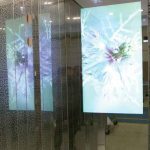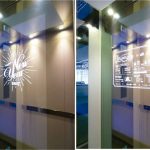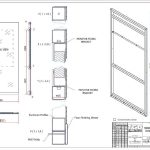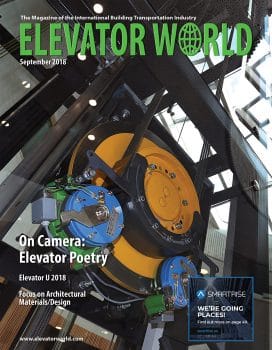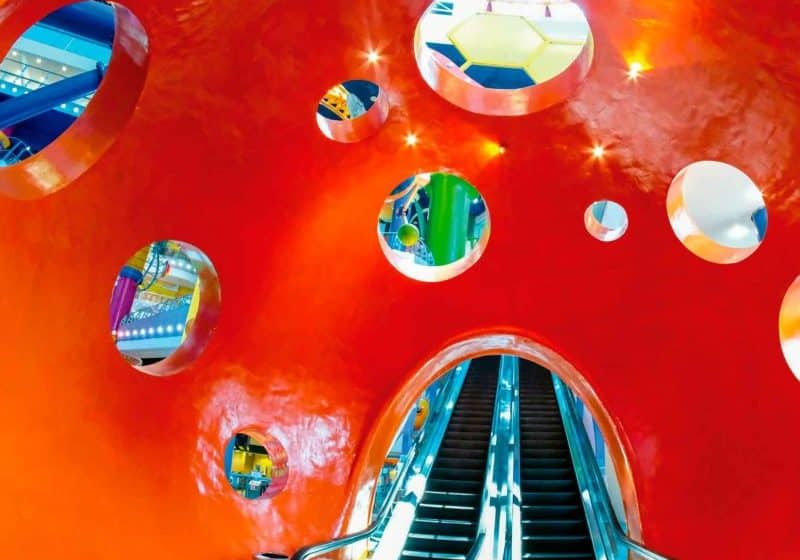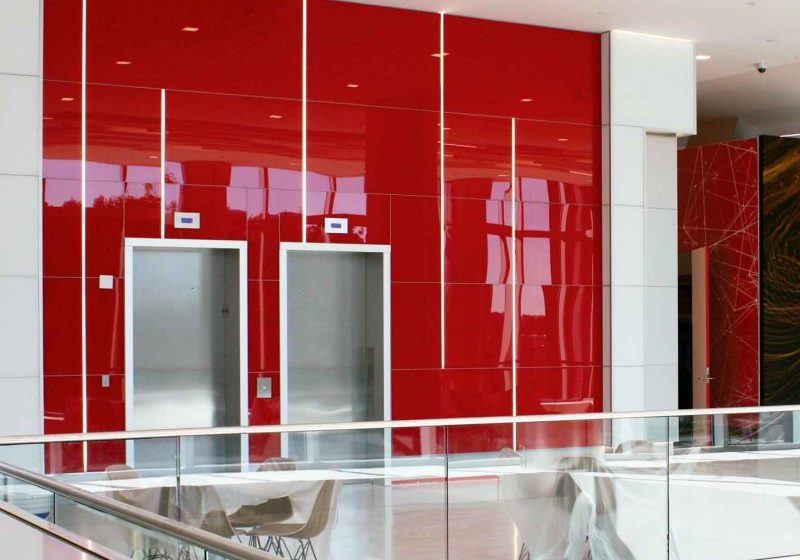Gateway, the Magic Mirror
Sep 1, 2018
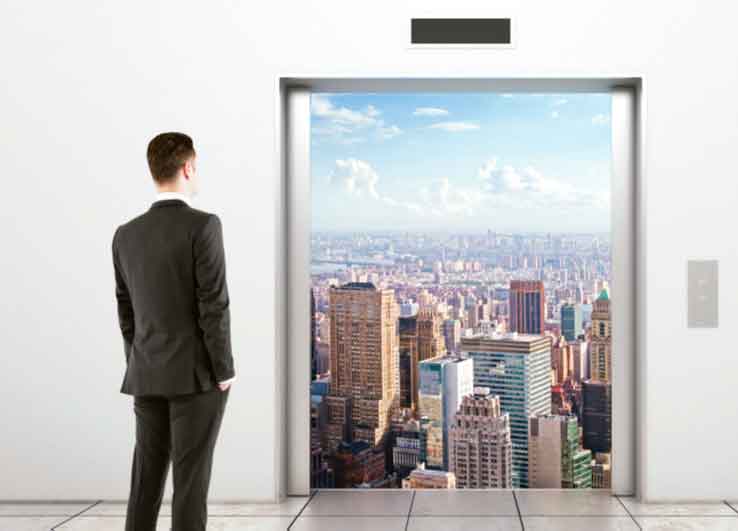
IoT application for lift cars
by Fabio Liberali and Alessandro Cremaschi
Gateway is an Internet of Things (IoT) technology applied to glass mirrors in lift cars. It transforms common lift-car mirrors into interactive touchscreen displays managed remotely via the internet. Unlike traditional cars’ video screens, Gateway has many different purposes:
- Interactive touchscreen display
- Digital signage and communication
- Emergency connection to 24-hr. servicing (through an additional micro camera)
- Maintenance support (direct video/audio connection between headquarters and onsite maintenance personnel)
The system is extremely light and thin, with no impact on car weight and space. Gateway is a tailormade product that can be adapted to both new cars and modernizations.
Introduction
Traditional Cars
The push button in the traditional car has the drawback of limiting communication between the user and operational center to merely an audio system. Furthermore, warnings, messages and information are traditionally displayed in the car by means of posting paper notices or using closed- circuit screens exclusively devoted to this function.
The main object of Gateway is to provide a car in which, unlike traditional equipment of this type, communication is not limited to audio signals, but also includes video signals and internet to provide features allowing the user to interact with the outside world and vice versa. Another object is to provide a car having, within a single system of communication, the function of displaying notices and general information messages, both useful for the user and commercially relevant, the dimensions of which do not affect the interior design or are undesirable in the smallest cars. This feature is particularly relevant, as it provides the lift owner the possibility to sell commercial communication/ advertising in the car.
The IoT Revolution
The IoT is the network of physical devices, vehicles, home appliances and other items embedded with electronics, software, sensors, actuators and connectivity that enable these objects to connect and exchange data. Each thing is uniquely identifiable through its embedded computing system but is able to interoperate within the existing internet infrastructure.[1-3]
Experts estimate the IoT will consist of about 30 billion objects by 2020.[4] It is also estimated that the global market value of IoT will reach US$7.1 trillion by 2020.[5]
A growing portion of IoT devices is created for consumer use. Examples of consumer applications include connected car, entertainment, home automation, wearable technology, quantified self, connected health, and appliances such as washers/ dryers, robotic vacuums, air purifiers, ovens and refrigerators/freezers that use Wi-Fi for remote monitoring.[6] Gateway applies such technology to lift cars.
Connect the Car to the Outside World
In traditional lift systems, cars are passive; i.e., they lack means suitable for communication, the ability to provide the user with audio and video signals, etc. If present, the auxiliary communication means (traditional TV screen, touchpad, etc.) affects the appearance and design of the space inside the car. Such devices have a limited quality in terms of design opportunities, video dimensions and brightness, and custom solutions. Moreover, TV screens and touchpads are exposed to various risks (e.g., vandalism and robbery).
Gateway provides new solutions. It hides the whole hardware behind a mirror, avoiding the above-mentioned risks. It provides architects and designers a new opportunity to create elegant lift cars. The “wow effect” is also added, deriving from the new communication and digital signage system. It also opens the door to multiple and real-time management of communication on every car from a single remote point. Its enhanced communication and interactive features are in accordance with Lift Directive 2014/33/EU and Machinery Directive 2006/42/EC.
Video With Touchscreen Technology
Gateway applies IoT to car mirrors, making a normal mirror a completely new multimedia tool connected to the internet. If switched off, it serves as a traditional car mirror. Optionally, it can become a full-video interactive touchscreen. This feature allows maintenance operators to read operational parameters directly on site and opens the door to many other options and services that need interaction between the system and user.
System Features
The system’s display is designed to operate 24/7 with high brightness. The video system can be permanently active or activated by sensors for proximity, light, weight, etc. Its touch mode can be activated/deactivated remotely or locally. The display’s features are:
- Resolution: full high definition at 1920 X 1080 (FHD)
- Connectivity options (either offline or online connection): local-area network (LAN), Wi-Fi, HDMI, DVI-D, OPS, USB, Secure Digital card, IR, audio or RJ45
- Display dimensions: 42, 49 and 55 in., among others
- Display orientation: horizontal or vertical.
Structure
Frame
The mirror is a tailor-made product with a frame made of special aluminum profiles that support the whole structure and affix to the wall of the car. The frame holds the tempered mirror and digital display. The affixing system, which can be personalized, has affixing points at the top and bottom transoms with screws that can be easily hidden. The frame provides a gap between the hardware and the wall for all heat to evacuate. The structure is lightweight and slim, and has negligible impact on rated load or car area. Mirror thickness is 35-40 mm.
Glass
The mirror glass is tough and reliable. It is based on the LU-VE Group/TGD technology used in doors for refrigerated cabinets in shops and supermarkets (heavy duty and impact resistant). The glass is tempered according to EN 12150 with thermally toughened soda lime silicate safety glass. Its tensile strength is 150 N/mm2, which is about five times that of normal glass. Moreover, in case of breakage, the glass shatters into small, blunt-edged fragments to help prevent damage and injuries. Finally, it has a reflective treatment providing a mirror-like effect when the screen is dark (turned off ), while it is transparent when the screen is lit (turned on).
Connectivity
The Gateway system has multiple possibilities for connection with the digital world. Once it is plugged into power with a simple PC cable, it can be connected to the local network by LAN or Wi-Fi and access the internet. Once connected, the system becomes a real interface that displays a variety of content that can be managed on three different levels.
Entry Level
Once connected, the system runs a basic software with a certain number of templates that can be customized through a remote PC connected to the same network. Once the contents are completed, the system asks for the scheduling time and duration, and transfers the contents to the display. It is possible to schedule a variety of content at different times and personalize (only existing) templates with pictures and videos (no connection to an RSS feed).
Pro Level
This level has all the features of the entry level but with a wider range of templates. It also provides the opportunity to create new content layouts and connect to an RSS feed. It still operates on a local network, but the system can manage a group of displays logged on the same network. The user can manage content distribution for all the connected devices from a single PC, including giving different scheduling and layout to each device.
Advanced Level
This level has all the features of the pro level, adding the opportunity to manage a network of devices connected to different local networks, regardless of physical location. It uses dedicated hardware and software to connect all the devices through the internet. This level is mandatory when the system integrates a TV camera or any other interface system controlled from a remote place.
Applications and Functions
Communication and Digital Signage
Digital signage is a subsegment of electronic signage defined as a “remotely managed digital display typically tied in with sales, advertising and marketing”[7] or as “a network of electronic displays that are centrally managed and individually addressable for the display of text, animated or video messages for advertising, information, entertainment and merchandising to targeted audiences.”[8] They can be found in public spaces, transportation systems, museums, stadiums, retail stores, hotels, restaurants, corporate buildings, etc., to provide wayfinding, exhibitions, marketing and outdoor advertising.[9]
In this case, the Gateway becomes a communication and digital-signage device, opening the car to the outside world. It can transmit information, photos, videos, websites, advertising and more, and remotely change the content in real time. The user can also ask and receive customized information, limited only by the services provided by the manager.
Emergency Mode
Calm passengers are safe passengers. In the event of an alarm, the new system might improve the safety of users, becoming a new bidirectional communication channel between the passenger and outside world. A micro webcam enables audio/visual communication between the safety/assistance service and passenger. The safety operator might see what’s going on inside the car: health emergency, special needs (i.e., writing messages on the screen for hearing-impaired passengers), presence of children, etc. On the passenger side, the possibility to see a human face (rather than just have an audio conversation) might reduce panic and fear, and better understand communication from the safety/assistance service.
Maintenance Support
Given the possibility to transform the mirror into the touchscreen of a remote computer (i.e., servicing headquarters, control room, etc.), Gateway can support maintenance personnel onsite. Maintenance staff can connect to the service center and access such files as manuals, instructions, documents, etc. It might also provide technical information regarding the lift system on its touchscreen.
Due to its interactivity, Gateway might also become a powerful device to support programmed- and predictive-maintenance service, displaying useful information/tools (graphics, video recordings, working parameters, etc.) to the onsite technician.
Conclusions
Gateway applies IoT technology to car mirrors, transforming them into new, powerful, revolutionary devices. The system can be installed not only inside the car, but also in the lift lobby to provide:
- Digital signage (product information, advertising and promotion, brand building, etc.)
- Audience measurement systems (number, gender and age group of passengers; opening/closing cycles; etc.)
- User activity (gaming, marketing, interaction activated by proximity sensors, mobile social engagement, etc.)
Some, if not all, of these features might be applied to lift cars to improve information, safety and maintenance. Lifts might provide real-time, user-friendly:
- Public and internal information (news, weather forecast, building directory and map, corporate messages, etc.)
- Local advertising
- Interactive video, which might reduce perceived wait time, both in cars and the lift lobby
- Safety information (emergency exit, building map, passenger behavior guidelines, etc.)
- Maintenance (user-friendly and easy-to-access technical information during service operation, remote file access, diagrams, functions display, etc.)
- Passenger tracking (gender, age group, boarding modes, etc.)
- Ask and receive customized information/service focused on the user’s needs (e.g., turning the touchscreen into a very large push button for people with impaired view)
Acknowledgements
The authors would like to thank Emanuele Eusebio and Luca Pasqualotto of LU-VE Group for their support and help in preparing this paper. Also, thanks to Wittur for providing us the images of the first Gateway in service. Thanks to Language Services professor Kenneth John Allan for his long-term support and brilliant ideas. Finally, special thanks to Dr. Gina Barney of Gina Barney Associates in the U.K. for her wise advice and help, but most of all for her friendship.
- Figure 1: Connecting the car to the outside world
- Figure 2: Gateway rendering
- Figure 3: First Gateway delivered; photo courtesy of the Wittur Group
- Figure 4: Alessandro Cremaschi and Gateway at Interlift 2017
- Figure 5: Communication examples
- Figure 6: Touchscreen feature
- Table 2: Gateway technical specifications
- Table 3: Frame and mirror structure for 49-in. model (dimensions: 1,100 X 2,150 mm)
- Table 4: Mirror car integration for 42-in. model (dimensions: 820 x 2,137 mm)
References
[1] Brown, Eric. “Who Needs the Internet of Things?” Linux.com (September 13, 2016, retrieved October 23, 2016).
[2] Brown, Eric. “21 Open Source Projects for IoT,” Linux.com (September 20, 2016, retrieved October 23, 2016).
[3] “Internet of Things Global Standards Initiative,” ITU (Retrieved June 26, 2015).
[4] Nordrum, Amy. “Popular Internet of Things Forecast of 50 Billion Devices by 2020 Is Outdated,” (August 18, 2016).
[5] Hsu, Chin-Lung and Lin, Judy Chuan-Chuan. “An empirical examination of consumer adoption of Internet of Things services: Network externalities and concern for information privacy perspectives.”
[6] “How IoT’s are Changing the Fundamentals of ‘Retailing,’” Indian Business of Tech, Mobile & Startups. (Trak.in: August 30, 2016, retrieved June 2, 2017).
[7] Schaeffler, J. “Digital Signage: Software, Networks, Advertising and Displays: A Primer for Understanding the Business,” NAB Executive Technology Briefings, 1st Edition, Focal Press (2013),
p. 1.
[8] Schaeffler, J., Digital Signage: Software, Networks, Advertising and Displays: A Primer for Understanding the Business, Focal Press (2013), p. 3-4.
[9] Wikipedia. “Digital Signage” (en.wikipedia.org/ wiki/Digital_signage).
Get more of Elevator World. Sign up for our free e-newsletter.


